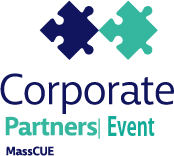
Briggs Elementary Students show off their talking trash can.
How do you draw creatures in? By laying out the welcome mat, of course! Fourth-grade and fifth-grade students at Briggs Elementary School in Ashburnham, MA are creating a variety of “habitat enhancements” to make the school’s science garden, vernal pool, and nature trail a more welcoming place for people and pollinators.
This fall, with help from a MassCUE Classroom Grant, fifth-grade students designed, created and installed everything from benches to a talking trash can to attract more human visitors. In the spring, fourth-grade students will focus on pollinators, by adding plants, bird baths, bee hotels, and more. Students are using a variety of tools to make their creations, including craft and art materials, recyclables, the school’s 3D printer, and sensor kits like the LEGO EV3, SAM Labs, Makey Makey, and PocketLab Weather.
Student Perspective

Welcome arch
Operation Welcome Mat emphasizes project-based learning that is grounded in engineering design challenges. To succeed, students had to apply STEM content and 21st-century skills like collaboration and communication. Sensors made student creations interactive, and gave students the opportunity to collect, analyze and share data and write algorithms and programs—key skills from the MA Digital Literacy and Computer Science Curriculum Framework, Common Core Math Standards, and Next Generation Science Standards. Most importantly, students learned a three-step approach to solving problems: Explore-Create-Share.
Click here to see students’ short, video reflections on what they learned in the project. Visit the students’ Operation Welcome Mat website to see a complete list of products students created.
Teacher Perspective

Briggs Elementary Students using the SAM Labs pressure sensor
During one of our first work days, two of the four fifth-grade teachers pulled me (the Digital Learning Coach) out into the hall. “We’re are a little out of our comfort zone,” they said. I don’t blame them—we had 88 students spread across four classrooms, the hallway, and the schoolyard, and every team was doing something different. The bridge group was on a Chromebook looking at examples of garden bridges. The sign group was looking through the big pile of wood heaped in a corner of the pod for a piece that was just the right size for the sign that would go at the entrance to the nature trail. The mileage marker team was outside with a parent volunteer, using the Map My Walk app on the parent’s phone to measure the length of the trail around the school. And that’s only three of the 28 teams. Teachers were asked to use a range of tools—Google’s Team Drive, Hyperdocs, FlipGrid, CAD modeling, and different sensor kits, each with its own software—many of which were new not only to students but also to teachers, like. Teachers also had to accept that they wouldn’t always know what the next day might bring. Our mantra became “we’re on safari!”, an attempt to embrace the idea of learning as an adventure that we were on WITH our students.
Tiffany Davis is a Digital Learning Coach for the Ashburnham Westminster Regional School District. In addition to a long-standing love affair with all things LEGO, her current passions include: 1. Using outdoor learning spaces to engage students and provide authentic opportunities to apply STEAM content. 2. Creating a Makerspace where kids have the time and tools needed to tackle open-ended design challenges. 3. Exploring elementary-friendly sensors kits that allow students to work with real-world data and experiment with programming.
– Tiffany Davis ( tdavis@awrsd.org )
 Print this post
Print this post



